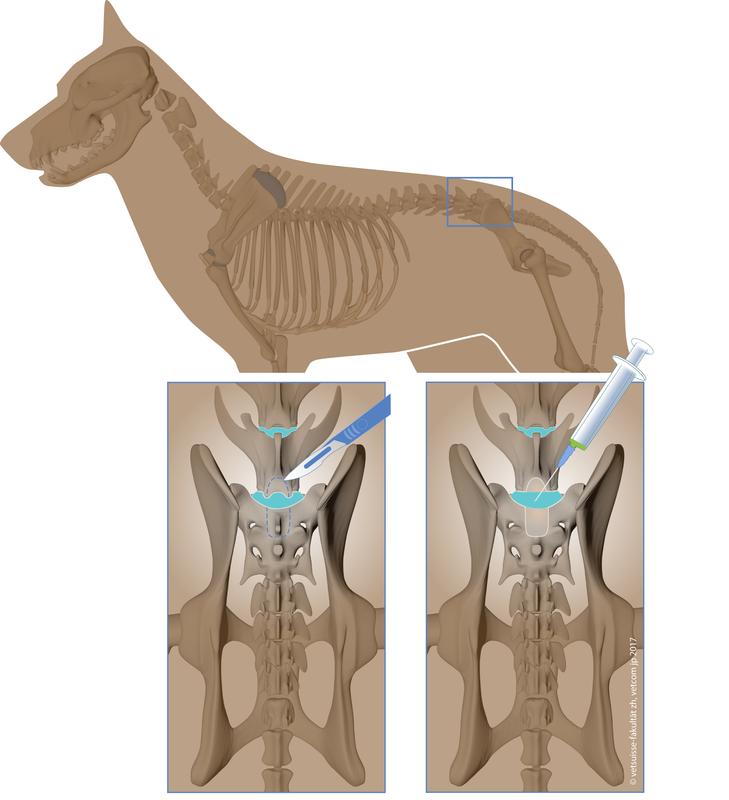With Stem Cells to New Intervertebral Discs

Stem cell therapy in dogs (Picture: Vetsuisse Faculty, UZH)
It is the “shock absorber” between the vertebrae of the spine, cushioning every step, bend and jump: the intervertebral disc. If the fibrocartilage tissue in the spine degenerates over time, an intervertebral disc can “slip” – pinching the medulla or nerves.
The consequences include intense pain or even paralysis. Not only people, but also dogs are often susceptible to this disease. Since intervertebral discs themselves cannot regenerate, the affected disc material is removed in an operation that can be performed on both people and animals. The pressure on the nerves and medulla disappears, but the degeneration of the disc remains.
Great hope has thus been placed on stem cell therapy as practiced by Frank Steffen, neurologist at the Clinic for Small Animal Surgery at the Vetsuisse Faculty of the University of Zurich. Stem cells are multipotent cells that can be differentiated into various cell types.
Steffen hopes that the stem cells will possibly form new disc cartilage once injected into a damaged disc. His study on three sick German shepherds demonstrate that a treatment with the body’s own stem cells are well tolerated – an important first step.
Gaining knowledge directly from the afflicted animal
Research on intervertebral disc regeneration is frequently performed using animal testing. At the Clinic for Small Animal Surgery in Zurich, researchers have taken another path: “Since we treat numerous dogs who spontaneously sustain a slipped disc every year, we have been able to gain important knowledge directly from animals that are actually afflicted with this disease,” Frank Steffen explains.
“Due to the similarity in pathology and the course of the illness, conclusions can presumably be drawn for the treatment of affected persons as well.” The project for the development of stem cell therapy in dogs is being conducted in cooperation with Swiss Paraplegic Research (SPR) in Nottwil, Switzerland.
The study on the sick German shepherds was organized as follows: With the permission of the dog owners, neurologist Frank Steffen and his team removed stem cells from the marrow of the pelvic bone of the affected animals. After the cleaning and preparation of the cell material in the laboratory, the stem cells were injected into the degenerated intervertebral disc during a disc operation that had become necessary for the animal in question.
“Our objective is for the stem cells to trigger cellular and molecular repair processes and, ideally, to form new intervertebral disc cells in order to contribute to the regeneration of the tissue,” Steffen says.
After tolerability, check effectiveness
The results are pleasing: The three dogs well tolerated the injections of their own stem cells and the researchers have determined no negative effects. However, later X-rays and magnetic resonance tomographies did not show clear indications that the damaged discs have already regenerated in comparison with the control group.
Not yet – of that, Steffen is confident. “Proving the tolerability of the therapy was our first important step.” Now he is working on the effectiveness of the stem cell injections, for example, with the targeted addition of growth factors. “If our method proves successful one day, it would be a pioneering step – for human medicine as well,” the neurologist says.
Literature:
Frank Steffen, Lucas Smolders, Anne Roentgen, Alessandro Bertolo, and Jivko Stoyanov. Bone Marrow-Derived Mesenchymal Stem Cells as Autologous Therapy in Dogs with Naturally Occurring Intervertebral Disc Disease: Feasibility, Safety and Preliminary Results. Tissue Engineering Part C: Methods. 4 May 2017, ahead of print. doi:10.1089/ten.TEC.2017.0033
Contact:
Prof. Dr. Frank Steffen
Clinic for Small Animal Surgery
Vetsuisse Faculty
University of Zurich
Phone: +41 44 635 84 47
E-mail: fsteffen@vetclinics.uzh.ch
Media Relations
University of Zurich
Phone: +41 44 634 44 67
E-mail: mediarelations@kommunikation.uzh.ch
http://www.media.uzh.ch/en/Press-Releases/2017/stem-cells-for-intervertebral-dis…
Media Contact
All latest news from the category: Health and Medicine
This subject area encompasses research and studies in the field of human medicine.
Among the wide-ranging list of topics covered here are anesthesiology, anatomy, surgery, human genetics, hygiene and environmental medicine, internal medicine, neurology, pharmacology, physiology, urology and dental medicine.
Newest articles

“Nanostitches” enable lighter and tougher composite materials
In research that may lead to next-generation airplanes and spacecraft, MIT engineers used carbon nanotubes to prevent cracking in multilayered composites. To save on fuel and reduce aircraft emissions, engineers…

Trash to treasure
Researchers turn metal waste into catalyst for hydrogen. Scientists have found a way to transform metal waste into a highly efficient catalyst to make hydrogen from water, a discovery that…

Real-time detection of infectious disease viruses
… by searching for molecular fingerprinting. A research team consisting of Professor Kyoung-Duck Park and Taeyoung Moon and Huitae Joo, PhD candidates, from the Department of Physics at Pohang University…





















